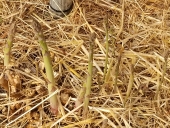
 1
1





 3
3




Tradition is not the worship of ashes, but the preservation of fire.
 4
4




Nails are sold by the pound, that makes sense.
Soluna Garden Farm -- Flower CSA -- plants, and cut flowers at our farm.
 2
2




Bryant said, Sweet Yellow, Crimson, Dutch White are great clovers to use in a feed plot or a pasture.
Invasive plants are Earth's way of insisting we notice her medicines. Stephen Herrod Buhner
Everyone learns what works by learning what doesn't work. Stephen Herrod Buhner
 2
2




Jeremy VanGelder wrote: At another house we set a piece of culvert on end above the access to the tank, then put a lid on the culvert. That way we don't have to dig it all up every time the inlet to the tank gets plugged.
Anne Miller wrote: Most folks don't recommend edible in the septic area.
 3
3




 7
7




 5
5




Megan Palmer wrote:@chard irking, what did you end up planting in the bed over your septic tank?
A few days ago, I dug up the bed of saffron in the photo above.
There were hundreds of corms, kept the biggest ones to replant and am selling the rest as a fund raiser for our community garden.
Our water tank is fed from a stream that often runs dry so we have dug a bore but need funds to buy and install a pump and generator.

| I agree. Here's the link: http://stoves2.com |


.jpg)





